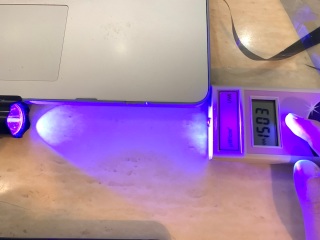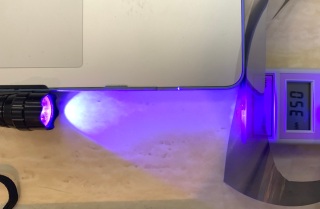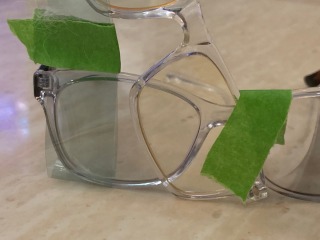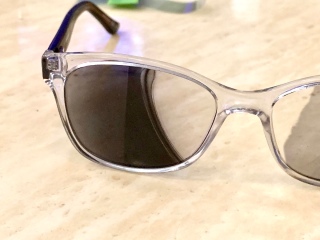Hello fellow Tesla owners,
Having just installed some window tint on my car, I'm curious if I'm now free from UV radiation while driving, so I decided to run a few tests to fulfill my curiosity.


I did some testing and the results were surprising and disappointing. According to my UV meter, the window tint was blocking 70% of the UV light, while a pair of $12 UV blocking reading glasses was able to block 99%. That's not what I want to see!
I was very curious, since there could be a hundred variables that could taint my result, I ended up running the following tests:
Lastly, I played with a very simple test - shine my UV flashlight onto my fiancé's pair of transition lens to see if the lens darken.


I left the UV light on for 30 seconds, and the performance between the window tint and the UV glasses is pretty apparent. Note that this is not definitive, as there is a chance that the transition lens reacts to wavelength above 400nm, but it help align with my UV meter's findings.
So now I'm very confused. Is there a specific way that "UV blocking" is measured by a standard committee which I'm unaware of?
I noticed that the most common equipment used in demo videos on YouTube are from EDTM, with their meters that display a percentage value. I'm curious as to how that value is calculated.
Their solar spectrum meter SS2450 detects UV at 350-380nm, while the UV Sentry UV1265 has a sensor that peaks at 380nm. Both seems to be very focused on UVA1 and doesn't seem to cover UVA2 and UVB. I wonder if that makes a difference with what I'm using. The closest I have is the VEML6075 which peaks at 365nm.
I have more window tint sample on order, and will be doing more testing in the coming weeks, and I will be sharing my results on my blog here. (WordPress.com) As well as this forum as often as I can.
So far, these are the results from my testing:

Upon further research, I found a 2008 report from WAAC(Western Association for Art Conservation) who tested a bunch of window tint and compared their UV rejection rate to the manufacturer's rate. They also found that some brands do not match their advertised rate. Most notable is 3M's Scotchtint Sun Control 66 only blocks 38% UV from their advertised 98%. I assume that today's 3M product works better, but we'll have to test to find out. Of their brands tested, Madico, Llumar, and Vista Window Film all tested at 99%, so I'll definitely try to get some films from these companies to test out. Unfortunately none of these brands are available online.
So to all fellow Tesla owners, beware that not all tint are made the same. I will keep testing more films when I get my hands on them. Professionally installed tint are not cheap and I hope that you're getting your money's worth.
If there are any members in the Bay Area, CA who has Suntek, 3M, Llumar, or other quality tint installed, I'd like to ask if I can drop by and test your window tint.
Having just installed some window tint on my car, I'm curious if I'm now free from UV radiation while driving, so I decided to run a few tests to fulfill my curiosity.


I did some testing and the results were surprising and disappointing. According to my UV meter, the window tint was blocking 70% of the UV light, while a pair of $12 UV blocking reading glasses was able to block 99%. That's not what I want to see!
I was very curious, since there could be a hundred variables that could taint my result, I ended up running the following tests:
- I used different UV metering equipment - (Solarmeter model 4.2 UVA meter, Sper Scientific UVA/B meter, homemade Arduino UV meter with an VEML6075 sensor)
- For light source I tested with my UV flashlight, as well as direct sunlight
- I tested performance of the tint alone, as well as the same tint installed on my car's window, in-case the glass itself blocks off some UVB radiation.
- Besides my UV reading glasses, I also tested my car's front windshield, as well as a pair of transition prescription glasses, and they all blocked 99% of UV radiation.
- I ordered additional window tint, from cheap tint sold on Amazon, to film from Filmvantage, SnapTint, and Suntek (with 3M on its way)
Lastly, I played with a very simple test - shine my UV flashlight onto my fiancé's pair of transition lens to see if the lens darken.


I left the UV light on for 30 seconds, and the performance between the window tint and the UV glasses is pretty apparent. Note that this is not definitive, as there is a chance that the transition lens reacts to wavelength above 400nm, but it help align with my UV meter's findings.
So now I'm very confused. Is there a specific way that "UV blocking" is measured by a standard committee which I'm unaware of?
I noticed that the most common equipment used in demo videos on YouTube are from EDTM, with their meters that display a percentage value. I'm curious as to how that value is calculated.
Their solar spectrum meter SS2450 detects UV at 350-380nm, while the UV Sentry UV1265 has a sensor that peaks at 380nm. Both seems to be very focused on UVA1 and doesn't seem to cover UVA2 and UVB. I wonder if that makes a difference with what I'm using. The closest I have is the VEML6075 which peaks at 365nm.
I have more window tint sample on order, and will be doing more testing in the coming weeks, and I will be sharing my results on my blog here. (WordPress.com) As well as this forum as often as I can.
So far, these are the results from my testing:
Upon further research, I found a 2008 report from WAAC(Western Association for Art Conservation) who tested a bunch of window tint and compared their UV rejection rate to the manufacturer's rate. They also found that some brands do not match their advertised rate. Most notable is 3M's Scotchtint Sun Control 66 only blocks 38% UV from their advertised 98%. I assume that today's 3M product works better, but we'll have to test to find out. Of their brands tested, Madico, Llumar, and Vista Window Film all tested at 99%, so I'll definitely try to get some films from these companies to test out. Unfortunately none of these brands are available online.
So to all fellow Tesla owners, beware that not all tint are made the same. I will keep testing more films when I get my hands on them. Professionally installed tint are not cheap and I hope that you're getting your money's worth.
If there are any members in the Bay Area, CA who has Suntek, 3M, Llumar, or other quality tint installed, I'd like to ask if I can drop by and test your window tint.
Last edited:


